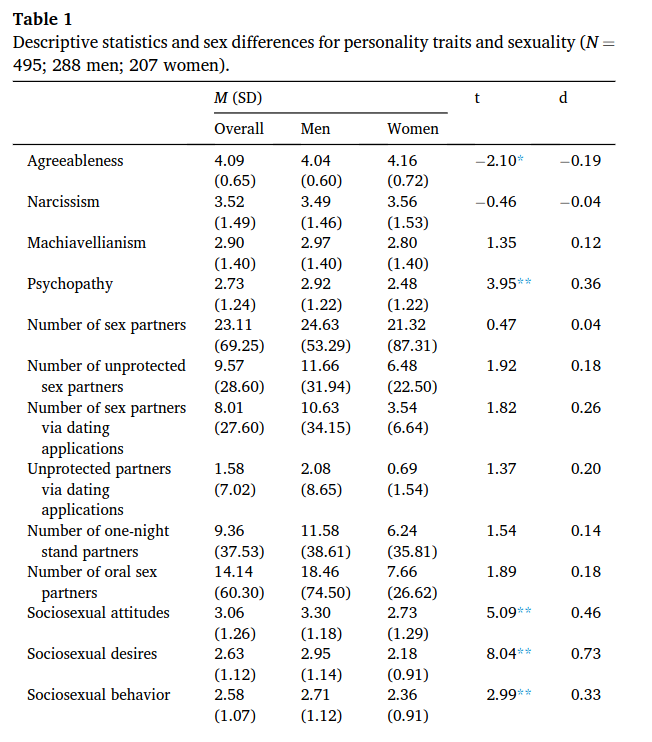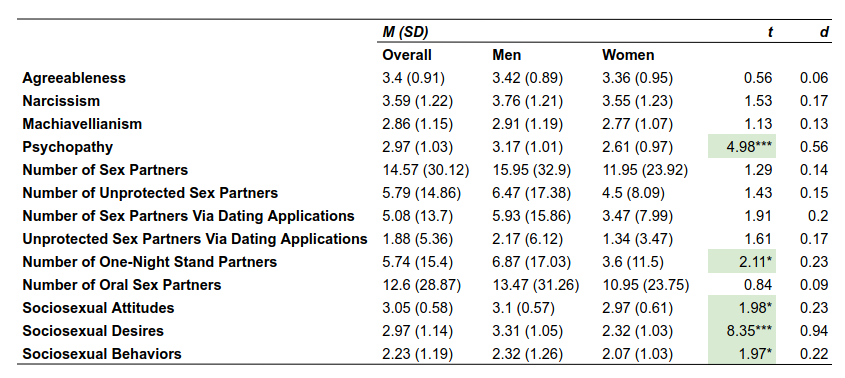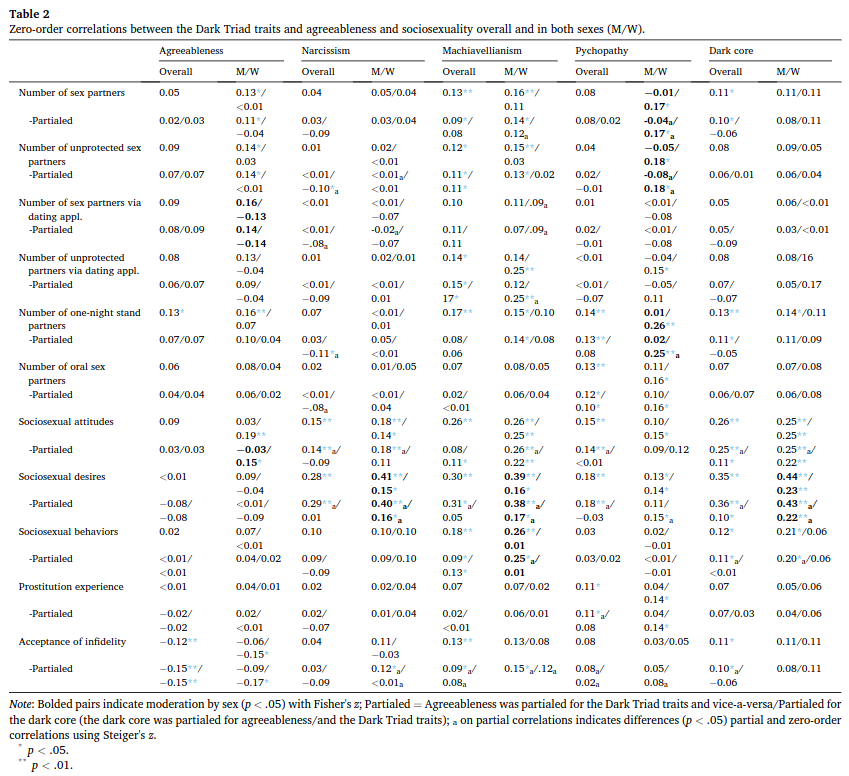Enjoy DatePsychology? Consider subscribing at Patreon to support the project.
A recent paper by Freyth and Jonason (2023) explored the relationship between the Dark Triad (DT) and sociosexuality. (Jonason is a prolific personality and evolutionary psychologist who does very good research — see his publications).
There has been some question in the past as to what extent low agreeableness is, in effect, the Dark Triad. In other words, when we look at the Dark Triad are we really looking at an underlying construct that is more or less synonymous with low agreeableness? If this were the case then we might expect associations (inverse) between agreeableness and sociosexuality similar to the associations (positive) we see between the Dark Triad and sociosexuality.
Alternatively, if the Dark Triad is wholly or partially distinct from low agreeableness then we would expect the two to predict sociosexuality differently and independently from one another. Further, the individual facets within the Dark Triad should predict sociosexual behaviors and outcomes differently. Individual facets should also predict sociosexual outcomes beyond the latent variance of the facets (the “dark core”).
Methodology
Freyth & Jonason (2023) Methods
Freyth and Jonason (2023) ran three personality measurements: a 15-item Big Five test (Schupp & Gerlitz, 2008), the Naughty Nine Scale for the Dark Triad (Küfner et al., 2015), and the Revised Sociosexuality Inventory (SOI-R) (Penke & Asendorpf, 2008). They also asked participants an additional series of questions about sociosexual behaviors (e.g. “How many unprotected sex partners have you had?”). They collected a sample of German-speakers from an online panel (N = 495, 207 Women). The mean age of the sample was 42.18 (SD 14.49).
Current Replication Methods
We used the same SOI-R and Naughty Nine and selected an English-language 15-item Big Five (Labat Marcos et al., 2023). We also asked the same additional questions about sociosexual behavior as in Freyth and Jonason (2023). Our sample was collected by snowball sample from two social media platforms (N = 344, 119 Women). The mean age of our sample was 32.53 (SD 10.34).
Results
Descriptives and Sex Differences
Table 1 shows the original descriptive table comparing sex differences from Freyth and Jonason (2023) and Table 2 shows our current results. Take a moment to compare the two — how are they similar and how are they different?


- We couldn’t reproduce the small sex difference in agreeableness (we had fewer women in our sample; it could be underpowered). We also found a significant sex difference in one-night stand sexual partners that did not emerge in the results of Freyth and Jonason (2023).
- Consistent with Freyth and Jonason (2023), we found sex differences in psychopathy and the three SOI-R measurements.
- Overall, the magnitude of the effects were fairly similar and in a similar pattern (e.g. sociosexual desire showed a much larger sex difference both in the original results and in ours).
Intercorrelations of the Dark Triad and Agreeableness
Freyth and Jonason (2023) found correlations between the three Dark Triad facets and agreeableness (Narcissism = 0.17, Machiavellianism = 0.22, Psychopathy = 0.17; all ps < .01). We found these for agreeableness and two facets (Machiavellianism = -0.13, Psychopathy = -0.25; all ps <.01), but not for narcissism.
Associations with Sexual Outcomes
Freyth and Jonason (2023) reported the percentage of tests for Machiavellianism, Narcissism, Psychopathy, and Agreeableness that predicted sociosexual behaviors and attitudes. Table 3 shows a comparison between those and the current results:

Similar to the original results, we found that Machiavellianism was the more robust predictor of sociosexual attitudes and behaviors. Dissimilarly, we found that agreeableness was a more robust predictor of sociosexual attitudes and behaviors while psychopathy was not. The percentage of tests that correlated with sociosexual behaviors and attitudes for narcissism was similar.
Additionally, in line with Freyth and Jonason (2023), we also found that machiavellianism was more closely associated with sexual outcomes in men while psychopathy was more closely associated with sexual outcomes in women (Table 4).

Partial Order Correlations: Is The Dark Triad Just Agreeableness?
Freyth and Jonason (2023) ran partial order correlations for all associations; this controls for a variable (agreeableness and the dark core in this case) to get an idea of what the relationship looks like when accounting for the third variable. They found that the magnitude of associations between dark traits tended to be larger when controlling for agreeableness (see Table 5, reproduced from the Freyth and Jonason).

We looked at partial order correlations only for the significant correlations we found and only for agreeableness as a third variable (Table 6). We also found a similar pattern; partial correlations were all the same magnitude or larger, indicating little to no influence from the trait of agreeableness.

Hierarchical Regressions With and Without Agreeableness
Freyth and Jonason (2023) ran a two step hierarchical regression with Dark Triad traits in the first model and agreeableness added to the second model. This will allow you to see if adding agreeableness can explain an additional portion of the variance in sexual outcomes. They found that agreeableness added only 1-2% additional variance in 3 out of 33 tests.
We performed this without splitting by sex and only had 9 tests (we did not include two items in our survey). Agreeableness in our results added 1-2% additional variance in 2 out of 9 tests (Table 7).

Discussion
In our replication we didn’t follow the methodology Freyth and Jonason (2023) exactly, but what we did was pretty close and our results lined up mostly with the previous findings. The descriptive statistics and sex differences we obtained were more consistent with the results of Freyth and Jonason than not. Machiavellianism emerged as the more robust predictor of sexual outcomes, similar to the original results. Machiavellianism was more closely associated with male sexual outcomes while psychopathy was more closely associated with female sexual outcomes, again similar to the original results. Agreeableness did not contribute much to the associations between Dark Triad traits and sexual outcomes. When we added agreeableness to regression models of the Dark Triad it did not improve the models much.
In our results we found that agreeableness was positively associated with having more sexual partners, more one-night stands, and higher sociosexual behavior for women only. In the original paper, more agreeable men were also more likely to have more sexual partners, and in our results agreeableness was associated with higher sociosexual attitudes in men. Why might more agreeable men and women be more likely to have more casual sex? Potentially, more agreeable men and women are more likely to approach and be approached. Their interactions might unfold in a more positive way that leads to more sexual encounters. Additionally, and in the case of women specifically, more agreeable women may be less likely to say “no” to sexual encounters they are not fully invested in (in effect, people pleasers). Agreeable women may be less effective at setting boundaries. In this sense, high agreeableness can be both a weakness and a strength for women.
For women, psychopathy was associated with having higher sociosexual attitudes. In general, men need less emotional attachment to engage in sex, whereas women are more likely to need an emotional connection. Psychopathy is associated with emotional deficits, which may be why women who are higher in psychopathy have a more casual view of sex. Freyth and Jonason (2023) found that psychopathy was not associated with more sexual outcomes in men and we found no associations for men nor women. As described in the original paper, this may be because psychopathy produces less desirable behavior in potential mates (even in short-term sexual contexts). This may be especially the case for men, in whom psychopathy may be expressed as aggression (women feel a need to be safe with potential mates, both in long and short term mating).
Narcissism, on the other hand, was associated with having fewer sexual partners and lower sociosexual behavior for women. Women who score higher in narcissism may feel they deserve a higher value mate and are less likely to engage with multiple partners due to having a higher perceived self worth. This is consistent with past research that has found more attractive women tend to have fewer partners on average (McClintock, 2011). Narcissism has also been associated with attractiveness both in men and women (Holtzman & Strube, 2010).
Machiavellianism had many associations with sexual outcomes, but only for men. Machiavellians are more manipulative and may be able to wheedle or coerce potential sexual partners (Jones & Olderbak, 2014). They may be able to talk others into sexual encounters that are less desired, or even engage in nonconsensual sexual strategies (e.g. date rape).
For men and women both, Dark Triad traits predicted having higher sociosexual desire. This association emerged in the original paper and in our results. An important thing to understand about the Dark Triad is that individuals high in the DT are effectively short-term mating strategists. This personality emerged to exploit an evolutionary niche that prioritizes quantity over long-term mating investment. Additionally, sex for men is a robust status signal (in particular to other men) and may also be a strategy for women to seek power or status within interpersonal relationships. Having more sexual partners may be both a form of ego validation for narcissists and a product of status-seeking. Individuals high in the Dark Triad likely desire more sexual novelty, but also desire to project the cues or signals associated with higher levels of promiscuity. For women high in the Dark Triad sex may also be one side of an exchange for status or resources.
Given the current results, who makes an effective short-term strategist? For men, agreeable machiavellians, and for women agreeable psychopaths. In effect, men and women who are likable enough not to repel potential mates and who are manipulative or fearless enough to frequently engage in short-term sexual encounters.
Additionally, the Dark Triad is more than just low agreeableness. Across the current results and the results in Freyth and Jonason (2023) we see that higher agreeableness is associated with more effective short-term mating strategies. If the Dark Triad were merely low agreeableness we might expect the opposite result. Instead, we see high agreeableness and high Dark Triad traits both predict more sexual outcomes.
References
Labat Marcos, A., Ribeiro Serra, F. A., Vils, L., & Scafuto, I. C. (2023). VALIDATION OF THE BIG FIVE PERSONALITY INVENTORY-15 (CBF-PI-15) SCALE FOR THE PORTUGUESE LANGUAGE AND EXAMPLE OF PRACTICAL APPLICATIONS IN PROJECT MANAGEMENT.
Freyth, L., & Jonason, P. K. (2023). Overcoming agreeableness: Sociosexuality and the Dark Triad expanded and revisited. Personality and Individual Differences, 203, 112009.
Holtzman, N. S., & Strube, M. J. (2010). Narcissism and attractiveness. Journal of Research in Personality, 44(1), 133-136.
Jonason, P. K., & Webster, G. D. (2010). The dirty dozen: a concise measure of the dark triad. Psychological assessment, 22(2), 420.
Jones, D. N., & Olderbak, S. G. (2014). The associations among dark personalities and sexual tactics across different scenarios. Journal of interpersonal violence, 29(6), 1050-1070.
McClintock, E. A. (2011). Handsome wants as handsome does: Physical attractiveness and gender differences in revealed sexual preferences. Biodemography and Social Biology, 57(2), 221-257.
Penke, L., & Asendorpf, J. B. (2008). Beyond global sociosexual orientations: a more differentiated look at sociosexuality and its effects on courtship and romantic relationships. Journal of personality and social psychology, 95(5), 1113.